
It was Donald Winnicott, of course, who coined the phrase good-enough in connection with parenting.
He first introduced the term in 1953 although he had worked on the concept for years and the idea is there in his advice to parents in his wartime radio broadcasts. Basically, it recognizes the need for children to learn that:
a mother is neither good nor bad nor the product of illusion, but is a separate and independent entity: The good-enough mother … starts off with an almost complete adaptation to her infant’s needs, and as time proceeds she adapts less and less completely, gradually, according to the infant’s growing ability to deal with her failure. Her failure to adapt to every need of the child helps them adapt to external realities.
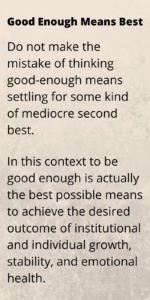 Good enough actually means best possible and that to be perfect is to fail. The perfect mother, for example, would always be there to meet the child’s every possible need and as a result there would be no room for the child’s growth as an independent, confident and a capable person. By analogy, the perfect school leader infantilizes everyone and drives them quite bonkers.
Good enough actually means best possible and that to be perfect is to fail. The perfect mother, for example, would always be there to meet the child’s every possible need and as a result there would be no room for the child’s growth as an independent, confident and a capable person. By analogy, the perfect school leader infantilizes everyone and drives them quite bonkers.
The idea of good enough takes reality as its starting point and growth and development as its raison d’être. It suggests that benefits (having all your needs met) comes with a disastrous downside.
There are always problems and people need to learn how to tackle them. Not alone, not abandoned, not as isolated individuals cut loose from the support system. It’s about learning to get better at something, while learning from being disappointed and from failure. It means seeing the world as full of complexity and it means adjusting to the fact we are all human and need to cut each other some slack.
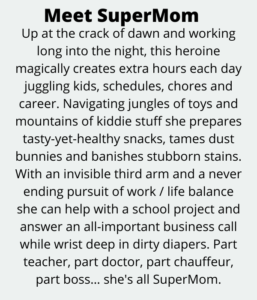
 I wonder what Winnicott would have made of SuperMom – the 6-inch plastic action figure who comes with 8 accessories – and two heads!
I wonder what Winnicott would have made of SuperMom – the 6-inch plastic action figure who comes with 8 accessories – and two heads!
And look! Here she is holding it all together.
 And now watch her juggle all those accessories and the extra head:
And now watch her juggle all those accessories and the extra head:
SuperTeacher SuperSchoolLeader and SuperBoss
Doesn’t seem to be a SuperTeacher action figure. No SuperHeadofSchool either. Go ahead – have some fun: Make up the descriptions!
There is a SuperBoss though. SuperBoss is male, white, and comes with a megaphone!
I’m drawn to Winnicott’s work because I can follow it (mostly) without getting too lost in complications and jargon and without having any professional qualification in the field of social work, medicine, psychology or psychoanalysis.
So much of what he wrote is really accessible and, well, interesting. In that, he was probably influenced by the women who helped him prepare the 60 of so broadcasts he made on the BBC in the 1940’s on programs like Women’s Hour. His was a voice of insight and reassurance for parents in a time of crisis.
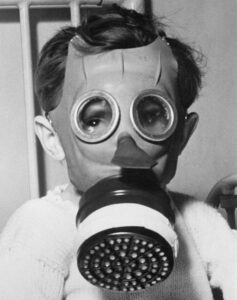
In a total war, civilians are in the front lines and close to 8,000 children were killed during the Blitz and about as many severely injured. Many were orphaned. One million children were evacuated and millions were displaced from their homes.
All this meant fear, anxiety and bewilderment for children and their parents. Lives were turned upside-down: Evacuation; air raids; deaths of family members, schoolmates and neighbors; the destruction of familiar landscapes; disruption to schooling; fear of gas attacks and invasion; rationing and shortages; fathers were called up and mothers went to work.
Two million houses were destroyed and there were 34 million changes of address during the six years of the war. Millions of children experienced bewildering and terrifying changes to their daily lives and routines. And that was just one small country.
Disruption and deprivation – and of course grief and loss – continued after the war. It was a period that also saw the establishment of the welfare state and a better deal for children. Winnicott and his wife Clare Britton were central to that work.
In those radio talks, Winnicott spoke directly to parents and especially mothers. Parents agonized over those separations and impossible choices they had to make. Rather than telling them what to do, Winnicott trusted in their ability to provide the care the children needed to grow and become healthy and independent beings. He reassured parents that their best efforts were good enough and indeed to try and do more – to be perfect and meet every need as the child grew – was the road to illness.
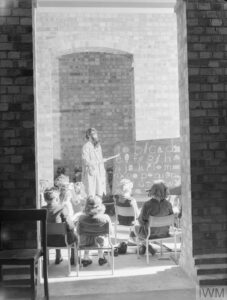
Winnicott thought parenting/ child care was the bedrock of society and the best hope for a better future. He thought better child care could change the world.
Everyday ordinary mothers caring for their infants was as important to the country and its future as the prime minister and his cabinet.
Winnicott called parenting: ‘the only real basis for a healthy society, and the only factory for the democratic tendency in a country’s social system.’
The war was a defining moment in Winnicott’s life and is the backdrop to his influential theoretical work.
The work he did with evacuated children during the war years, was often in partnership with the woman who became his wife – Clare Britton. Her brother James Britten was one of my teachers and I remember getting him to talk about Winnicott one night over a pint at The Rose and Crown. Pretty much all I can remember is the homely detail that Winnicott used to open the door and greet his patients in his carpet slippers.
Clare and Donald Winnicott worked with children displaced by war and especially with those too difficult or delinquent to be placed in homes. She was a social worker and children’s advocate. He was a pediatrician and psychoanalyst. It was a most productive partnership and many of Winnicott’s key concepts – the holding environment and the transitional object are prefigured in Britton’s description of her work with damaged children.
I love Britton’s description of how Winnicott worked in his official capacity as a clinical supervisor. She defined his role and made it work.
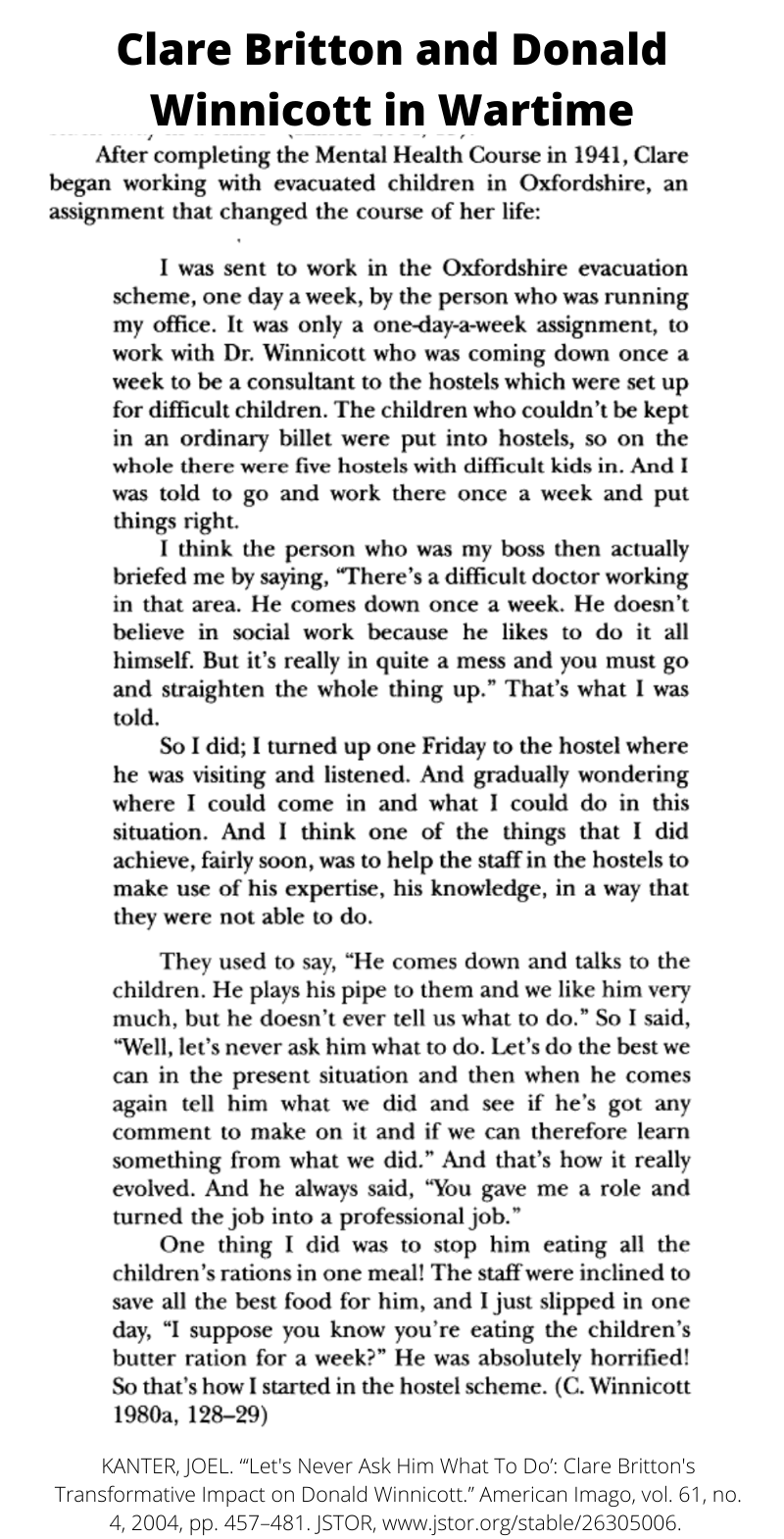
The sound of breaking glass took on epic proportions
In his work with children and especially in his work with those who managed the hostels for the most difficult and damaged children Winnicott learned a humbling and powerful lesson about the therapeutic environment. And don’t you just love this:
“Perhaps the boy had done no more than burn down a haystack or obstruct a railway line….” It reminds me of the classic Monty Python sketch The Mouse Problem that includes the line from the wise psychiatrist: I mean, how many of us can honestly say that at one time or another he hasn’t set fire to some great public building? I know I have.”
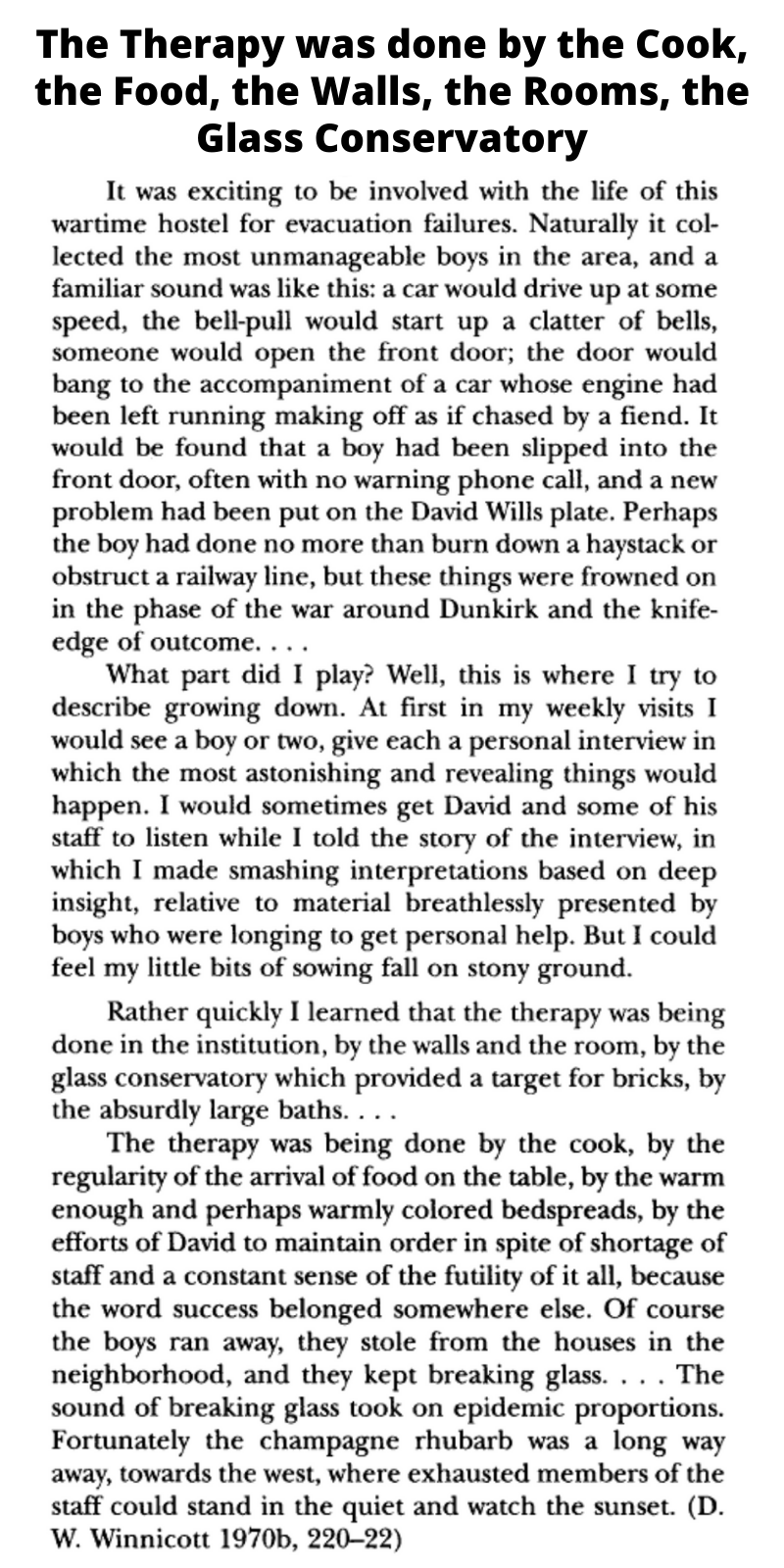
Winnicott knew that sometimes delinquency and breaking windows can be the sign of mental health and recovery.
But what about those good enough schools and good enough school leaders? Have to get to all that in the next post.
The featured image btw is the second of the six panels in the mural Fantasy Garden by Daphne Gradidge. Look at how perfectly planned and orderly everything is. No messy weeds. Everything tightly pruned and perfectly aligned. Desperately in need of a good-enough landscaper to restore it to health.



I think the most valuable work I have read recently says that the most growth comes when the ruptures are repaired. That is when the good enough mother blows it and then apologizes. Apparently that does the most to grow the relationship. “Power of Discord” by Tronick.
According to our current culture, nothing a mother does is ever good enough. At a certain point you just have to stop listening.
Sounds about right. Winnicott would agree.
I was a ‘good enough’ mother and it worked for me. Such a strain on parent and child to have a perfect mother. Winnicott was a bit of a mixed bag; I guess he was a ‘good enough’ psychotherapist.
Shrinks are all bonkers anyway. It’s why they go into the business. But seems to me Winnicott was mostly benign. And I do like his imaginative evocations of what the world must seem like to a baby.
Funny thing, but I’d not heard of Winnicott until I read Kate Atkinson’s Behind the Scenes at The Museum. The things we take for granted, hey? You’re extending my understanding of him hugely. Thank you. What a fascinating man he was.
Yes. He was. And I’ve enjoyed reading about how significant Clare’s contributions were to the development of his theories. That’s new information for me. And I love reading about their experiences with evacuees and delinquent children.